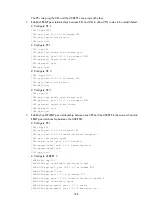
310
[PE2] bgp 600
# Configure the capability to advertise labeled routes to IBGP peer 4.4.4.9 and to receive labeled
routes from the peer.
[PE2-bgp] peer 4.4.4.9 as-number 600
[PE2-bgp] peer 4.4.4.9 connect-interface loopback 0
[PE2-bgp] peer 4.4.4.9 label-route-capability
# Configure the maximum hop count from PE 2 to EBGP peer 2.2.2.9 as 10.
[PE2-bgp] peer 2.2.2.9 as-number 100
[PE2-bgp] peer 2.2.2.9 connect-interface loopback 0
[PE2-bgp] peer 2.2.2.9 ebgp-max-hop 10
# Configure peer 2.2.2.9 as a VPNv4 peer.
[PE2-bgp] ipv4-family vpnv4
[PE2-bgp-af-vpnv4] peer 2.2.2.9 enable
[PE2-bgp-af-vpnv4] quit
# Redistribute direct routes to the routing table of vpn1.
[PE2-bgp] ipv4-family vpn-instance vpn1
[PE2-bgp-vpn1] import-route direct
[PE2-bgp-vpn1] quit
[PE2-bgp] quit
5.
Verify the configuration:
After the configurations, PE 1 and PE 2 can ping each other:
[PE2] ping –vpn-instance vpn1 30.0.0.1
[PE1] ping –vpn-instance vpn1 20.0.0.1
Configuring carrier's carrier
Network requirements
Configure carrier's carrier for the scenario shown in
•
PE 1 and PE 2 are the provider carrier's PE switches. They provide VPN services for the customer
carrier.
•
CE 1 and CE 2 are the customer carrier's switches. They are connected to the provider carrier's
backbone as CE switches.
•
PE 3 and PE 4 are the customer carrier's PE switches. They provide MPLS L3VPN services for the end
customers.
•
CE 3 and CE 4 are customers of the customer carrier.
The key to carrier's carrier deployment is to configure exchange of two kinds of routes:
•
Exchange of the customer carrier's internal routes on the provider carrier's backbone.
•
Exchange of the end customers' VPN routes between PE 3 and PE 4, the PEs of the customer carrier.
In this process, an MP-IBGP peer relationship must be established between PE 3 and PE 4.
















































